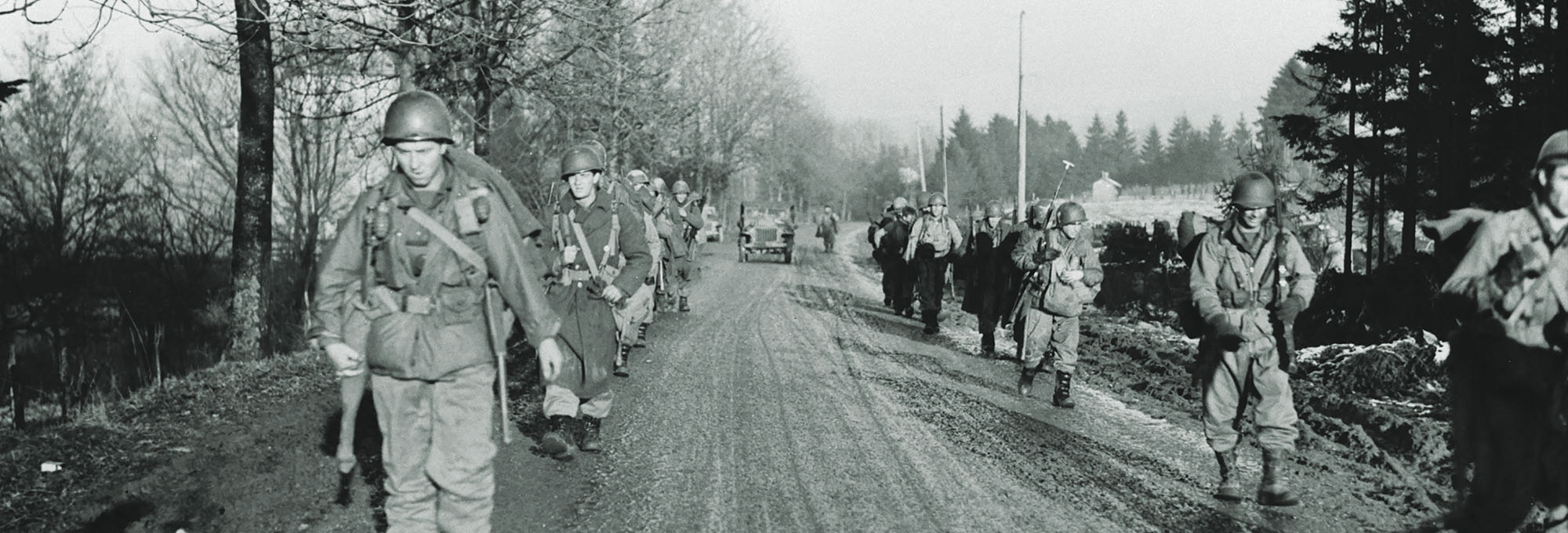Private Roger Carqueville was half asleep in the headquarters’ orderly room when the duty officer burst in.
“Carque, alert the company. We’re moving out.”
Carqueville rousted his fellow paratroopers, many of whom had gone to sleep in anticipation of leaving the next morning on a three-day pass to Paris. Instead of donning their dress uniforms, with silver jump wings and spit-polished jump boots, they slipped into their well-worn combat fatigues.
The men of the 551st Parachute Infantry Battalion grabbed their gear and assembled in the cold night to await further orders. It was December 16, 1944. No one seemed to know what was going on, but it was clear that nobody would be going to Paris. The troopers were dismissed to shove personal belongings into their barracks bags, draw their weapons, and stand by.
It was a drill they were familiar with. As an independent battalion—never permanently assigned to a parent unit—the 551st was routinely dispatched like a fire brigade to bolster the front where needed. Such independence fostered a magnificent esprit de corps in the ranks but, as the 551st’s odyssey would reveal, there were distinct downsides. The battalion was often overlooked in terms of supplies. And it usually drew the missions no one else wanted.
FORMED IN LATE 1942, the 800-man battalion was initially deployed to Panama in case the Axis made a move against the Panama Canal. From the moment he took command, Wood G. Joerg—then a 27-year-old major hailing from Eufaula, Alabama—wanted his battalion to be unique. Their colors were purple and yellow, and a large silver eagle with the Spanish motto—“Aterrice y Ataque” (Land and Attack), a nod to their Panamanian mission—dominated their insignia.
The unit’s call to action was “Get Off Your Ass!” and it was in Panama that Joerg started referring to his men as “GOYA birds,” “GOYAs,” or just “birds.” Joerg didn’t expect angels within his ranks; he valued initiative and individuality over rules and discipline. The battalion cultivated a rowdy reputation, bolstered by legendary drinking and fighting and exacerbated by a lack of enemy action. One GOYA, a former professional boxer, was feted for single-handedly KO’ing six MPs.
The GOYAs thought they were sure to see action in June 1943, when they were tagged to spearhead an airborne attack on the West Indies’ island of Martinique. American intelligence believed the island, under the control of Vichy France, was a safe harbor for German U-boats wreaking havoc on American shipping. But the local French naval commander surrendered the island before the invasion took place.
The unit returned to the States in September 1943, where its men spent their time training and getting into more trouble at Camp Mackall, North Carolina. After returning there from a 21-day furlough, the GOYAs reportedly held one of the U.S. Army’s highest VD rates. The discipline issues got nothing but worse, and soon nearly 200 of the troopers were in the stockade for being absent without leave.
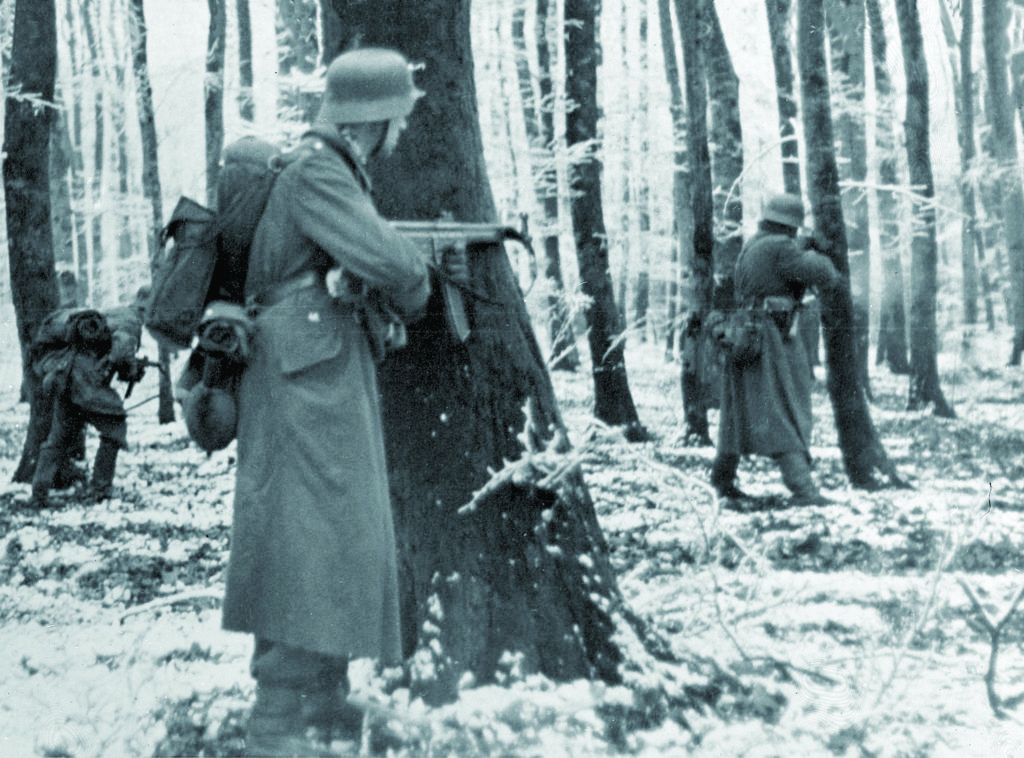
Embarking for Europe in April 1944 seemed to quell their restless nature. After a few months of training in Italy, the GOYAs jumped into occupied southern France in mid-August as part of the cobbled-together 1st Airborne Task Force. Their daylight drop near the village of La Motte marked the beginning of a 95-day campaign that ended with the battalion holding an isolated 40-mile front in the Maritime Alps. The GOYAs conducted ski patrols to cover their sector and harass the Germans. They turned in most of their heavy cold-weather gear when they arrived in northern France in early December for rest and refitting.
NOW WAITING FOR THE WORD to move out, the GOYAs spent Sunday, December 17, milling around their barracks in Laon. The former French military billets were a tantalizing 75 miles from Paris, liberated that August. But, unknown to the troopers, about 100 miles in the opposite direction, the Germans had launched a massive surprise offensive through the Ardennes Forest, igniting what has be-come known as the Battle of the Bulge.
Hitler’s attack, intended to slice through the Allies and seize Antwerp and its valuable port, was a desperate gamble that relied on almost everything going right at a time when German fuel supplies and unit strengths were in decline. But there was no denying that the offensive’s violent opening salvo of artillery and tanks, followed by swarms of German panzergrenadiers and paratroopers, had succeeded in punching through the Allied lines in Belgium.
The pandemonium of the breakthrough rattled General Dwight D. Eisenhower’s staff at Supreme Headquarters. They moved quickly to organize the disarray—but accurate information from the front was in short supply. To ease the logistical burden, Eisenhower placed some of his forces under the temporary control of British field marshal Bernard L. Montgomery.
Multiple delays gave rise to rumors among the GOYAs of sitting this one out. But those hopes were dashed when Wood Joerg, now a lieutenant colonel, returned at midnight from a briefing at 82nd Airborne Division headquarters. Joerg confirmed they were to move out as soon as possible. Their destination: Bastogne, Belgium.
Halfway to Bastogne, though, panzers cut off the convoy’s route and the 551st’s orders were rescinded. The battalion was now to report to the 30th Infantry Division near Stavelot, about 40 miles to Bastogne’s northeast. Forced to skirt the southern flank of the German advance, the GOYAs’ journey became a multiday, circuitous marathon; their trucks slid off slick roads, backtracked under artillery fire, were rerouted by MPs, and were occasionally strafed by marauding enemy aircraft.
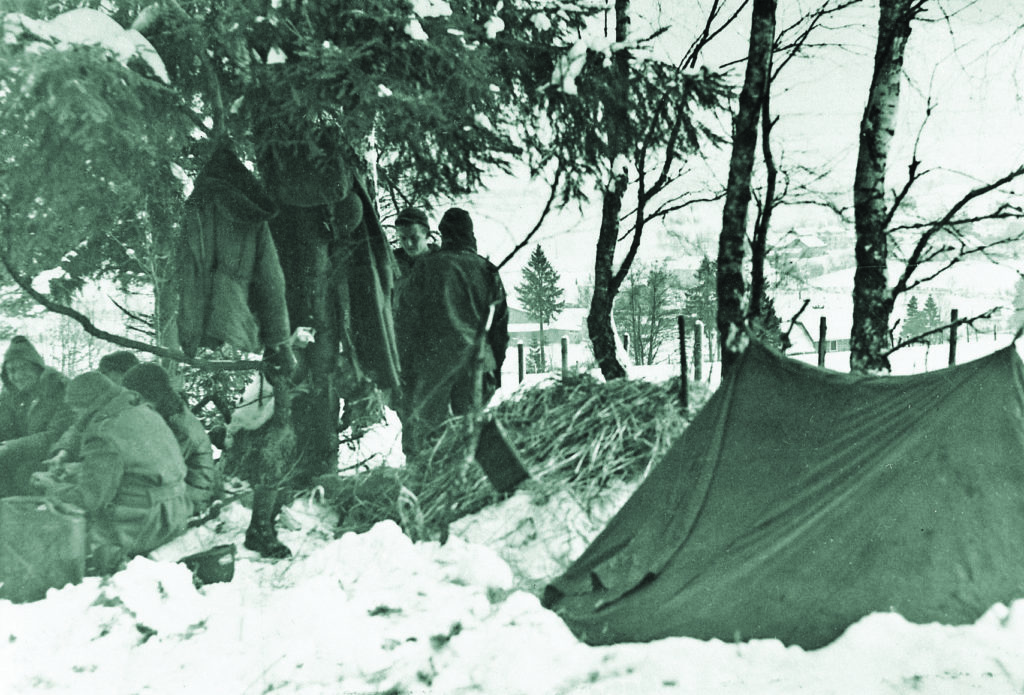
Separated by their travails, the vehicles trickled into Stavelot on December 20 and 21. Winters are severe in the region—especially so that year, with wind, bitter cold, and frequent snow. On the 20th, snow had begun falling again. By the time all the GOYAs had arrived, the enemy advance on the northern shoulder had been largely halted. Through a combination of determined Allied defenses, air power, and German logistical nightmares, the tanks and half-tracks of the German 1st SS Panzer Division had ground to a halt in the snow. The division was now fighting a desperate rear-guard action, and needed time for their remaining units to escape before they were completely annihilated.
THE GOYAS WERE SOON transferred back to the 82nd Airborne and placed into reserve positions a few miles to the west, near Rahier. There, their primary adversary was the freezing temperatures. The troopers spent Christmas and the next two days trying to stay warm, dodging enemy artillery shells, and—in the case of the 82nd’s commander, Major General James M. Gavin—growing impatient. Field Marshal Montgomery, in an effort to tidy up his lines, had ordered several units to withdraw from seized terrain and fall back several miles to the main frontline.
Gavin disagreed with Montgomery’s strategy; he didn’t like paying for the same real estate twice. But if he couldn’t attack, Gavin wanted his division aggressively needling the enemy. He tasked the GOYAs with a raid on the night of December 27. It would be against elements of the 62nd Volksgrenadier Division and the 9th SS Panzer Division, dug in around a cluster of stone farmhouses called Noirfontaine, three or four miles beyond the frontline. Joerg’s birds were to get in, wreak havoc, grab a prisoner or two, and be back before sunrise.
Given just a few hours’ notice, Joerg and his company commanders studied maps and reconnaissance photographs while the men scarfed down C-rations, cleaned their weapons, and steeled themselves for a night attack.
As the troopers crunched through the snow, covering U.S. artillery rounds warbled overhead to crash into the cluster of houses and barns. Joerg deployed the battalion’s three rifle companies: B Company moved in to set up a base of fire, while the two assault companies, A and C, swept through the tiny village. The 551st’s 81mm mortars set up 800 yards short of Noirefontaine. Lieutenant Robert Buscher had scrounged four additional mortars, doubling the battalion’s allotment. His men had perfected a rapid-fire technique to serve as the GOYAs’ mobile artillery; dur-ing the raid they hurled more than 400 shells onto enemy positions.
C Company’s Lieutenant Dick Goins positioned three Browning machine guns on the attack’s left flank and poured fire into the buildings. Meanwhile, his commander, Captain Tims Quinn, spotted a German Panzer IV tank. He dispatched two bazooka teams, yelling, “Don’t come back unless you are dragging them goddamn Tigers by the tail!” The men returned a few minutes later having knocked out one of the panzers with the rest in retreat.
A burning barn added an eerie glow to the nighttime scene and, in the pandemonium, there were several confused “friendly” shootouts. Fortunately for the 551st, the only casualties from the latter were a couple of creased helmets and some bruised egos. The GOYAs had caught the enemy by surprise. “Krauts were running all over,” recalled Sergeant Jack Carr. “Some of our guys walked right up and shot the Germans in their foxholes.”
At 2:30 a.m. the GOYAs withdrew, herding more than 20 POWs back through the woods and leaving some 50 enemy dead, at a cost of four killed and 15 wounded.
THE INEVITABLE ORDER for a full-scale Allied counterattack came six days later, on January 2. The 551st was now attached to the 517th Parachute Infantry Regiment and would be on the left flank of the 82nd Airborne’s assault to push the Germans back.
At 8:30 the morning of January 3, after a hot meal of pancakes and beef stew, the GOYAs marched south toward Saint-Jacques. Orders had come down for those who still had them to leave their cumbersome wool overcoats and rubber overshoes behind. The bulky cold-weather gear hampered rapid movement; they would attack in their standard-issue jump boots and olive fatigues. There was a lot of grumbling but, to their later regret, the men complied.
The troopers of the 551st—by then a 643-man force—loped forward, their breaths fogging the air. They high-stepped through two feet of snow as they advanced: A Company on the left, C Company on the right, with B Company bringing up the rear. The shortage of manpower required the cooks to serve as ammunition bearers. German Nebelwerfer rockets screamed overhead and the occasional short round of friendly artillery kept the troopers diving into the snow. Their first obstacle was crossing the icy Baleur River. There was no way around it and everyone got their feet wet.
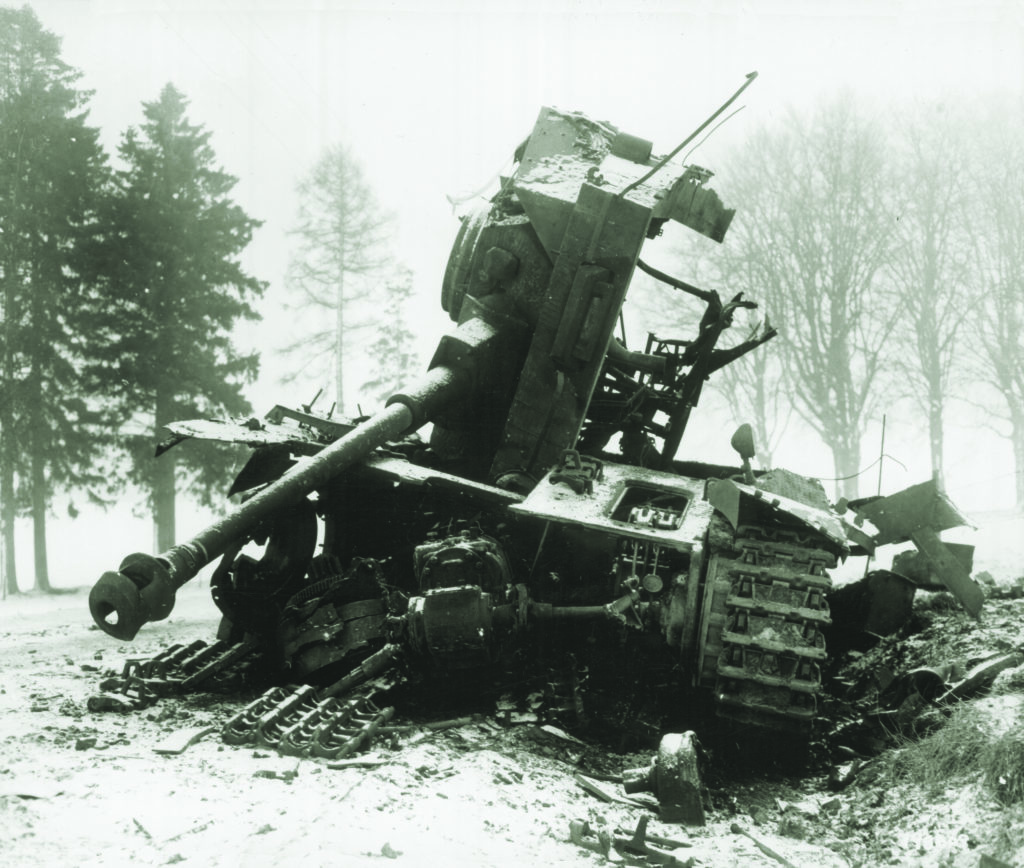
Panzergrenadiers of the 2nd and 9th Panzer Divisions were waiting for them, having used Montgomery’s withdrawal to their benefit. They were well dug into hilltop positions and the half-mile span of open ground to their front gave them all the advantages. Attacking uphill, the GOYAs would stand out like targets on a rifle range.
The panzergrenadiers’ mortar and artillery fire hit the 551st while they were still surveying the enemy positions from the tree line. An 88mm round vaporized one of A Company’s three-man mortar squads. Soon another shell wiped out the forward observer team: there would be no calling for artillery support.
Joerg, standing in the open, directed his men forward. A Company surged into the attack. The Germans let them get 200 yards into the field before opening up with at least six machine guns. The rounds ripped into the paratroopers’ formation, wounding the company’s captain; Lieutenant Keith Harsh assumed command. He had been hit, too, but refused to be evacuated.
“You had two choices,” Sergeant Bill Dean said. “You could get up and try to get away and they’d shoot you with the machine guns, or you could lie there and get shot with artillery.”
The man next to Dean went down. “He was a nice-looking kid, about 18,” Dean recalled. “He got shot in the throat and he looked at me with a desperate plea in his eyes. I looked away—I never did look back at him. He was blowing red bubbles in the snow.”
German tanks joined the melee, their main guns flashing as they launched deadly 75mm rounds. An intrepid GOYA bazooka gunner circled wide and took out one of them with a hit just above the tracks. The remaining panzers clanked away to safer ground.
From the right flank, Tims Quinn saw A Company pinned down. With a rebel yell, he led the men of C Company in a charge up the slope. They made good progress until the Germans pivoted their guns. The savage barrage cut down 45 troopers in less than 15 minutes.
Joerg committed B Company and, together with remnants of the other two badly hit companies, they pushed the grenadiers off the hill. As the sun set and the temperature dropped, tempers flared over the day’s slaughter: 189 GOYA casualties. In retaliation, Joerg’s troopers executed at least eight German prisoners without debate; some witnesses claimed the number was more than 20. One trooper, overflowing with grief and fury, even snapped off a few shots at a distant group of GIs wearing overcoats. Thankfully, he missed.
The troopers searched frantically for their wounded. If a man was left in the snow, subject to the sub-zero temperatures, he would freeze to death. The officers ordered their men, all of whom were without sleeping bags, to stay on their feet. They stomped their boots and, in some cases, marched circles around trees to stay awake, but at least a dozen GOYAs who lay down never got back up, dying of hypothermia.
Their misery continued. A steady stream of frostbite cases—many with blackened noses, fingers, and toes—were evacuated to aid stations. Officers began slapping their men to keep them awake. Those who lay down for even a few minutes found themselves frozen to the ground and in need of help to get up. The exhaustion took its toll. After their next attack—on January 4, at the town of Dairomont—some of the GOYAs went berserk, beating the corpses of stubborn German defenders so violently they broke the stocks of their rifles. By the evening of January 5, battle casualties and cold-weather injuries had reduced the battalion to half strength: 325 troopers, including 30-odd fresh replacements.
On the afternoon of January 6, the GOYAs were reassigned yet again, this time to the 504th Parachute Infantry Regiment. But, due to the fog of war or to distraction, the handoff was bungled. The 82nd staff documented the transfer, but there is no record of the 504th formally recognizing the attachment. The confusion would seal the GOYAs’ fate.
THE GOYAS’ NEXT ATTACK was to take place first thing the morning of January 7. Joerg was exhausted; most of his men were in a state of near shock. That night the men in the command post heard an exasperated Joerg arguing over the radio—exactly with whom has never been established. He wanted the attack called off. The GOYAs had had enough. Whoever was on the line denied the request.
Holding back tears, Joerg huddled with his company commanders to plan their next assault—this time against the rocky crag of Rochelinval, occupied by approximately 500 German grenadiers who were holding the last bridge across the nearby Salm River for their retreating comrades. Lieutenant Donald “Big Dog” Booth’s A Company—down to 80 men divided into two platoons—would be in the lead. There wasn’t a lot of optimism about their chances of surviving the near-frontal attack. “I knew we were all going to die,” Lieutenant Dick Durkee, one of the platoon leaders, later admitted.
At 6:45 a.m. they skirted the tree line to get into position, crunching through the snow as quietly as possible. Durkee fired a yellow flare—the signal they were in position—while a forward observer whispered into the radio, calling for artillery. Bathed in the eerie pulsing glow of the arcing flare, the GOYAs waited.
Four American shells sailed overhead and exploded, harmlessly off target. Through a broken and garbled radio connection, the forward observer made frantic pleas for more, but the supporting artillery unit claimed that the GOYAs’ target was outside their fire zone. The four rounds were all they would get.
The sun was now up, and the troopers still had to cross an open field before reaching the base of the steep ravine leading up to Rochelinval. When Booth realized the situation wasn’t going to get any better, he ordered the attack forward.
The German machine guns, including at least two captured water-cooled Brownings, were well positioned. The first 551st man fell almost as soon as he stepped out of the woods, killed by a headshot. A sustained burst cut Booth, who was waving the men forward, nearly in half. The devastating fire mowed the company down; the dead sprawled along the base of the hill.
“They were laying this way and that, some face-up staring at the sky with sightless eyes, and others face-down in the snow,” Durkee recalled.
Corporal Robert H. Hill witnessed the bloodbath. Almost all of his best friends were lying in front of him, dead. Before rage or anguish could even register, he dropped his M1 Garand and sprinted forward. Scooping up a Browning Automatic Rifle from a downed comrade he charged up the ravine, spraying the German positions. He was hit twice and fell to his knees, still firing. A third shot ended his life.
Dick Durkee was not far behind him, with a bazooka gunner who fired almost point blank into a machine-gun nest. Durkee tossed a few hand grenades and crawled to the crest of the ravine. Seeing Private Pat Casanova several yards down the hill, he yelled for him to bring the rest of the men up.
“Sir, they’re all dead,” Casanova shouted back. A Company’s seven survivors withdrew.
Meanwhile Wood Joerg, who had established his forward command post not far from A Company’s point of departure, was desperate for information. The three tanks expected to support the assault were nowhere to be found and, making matters worse, the Germans began lobbing in artillery. Shells peppered the cluster of trees where the GOYAs’ C Company waited in reserve. Joerg, pacing, returned to his radio team, sitting down to study the map and sort out the mess.
An artillery round exploded a few yards to the group’s front, followed by a second overhead burst. A shard of shrapnel pierced Joerg’s steel helmet—an image forever burned into the memory of Lieutenant Richard Hallock, who watched his mortally wounded commander slump onto his side. Roger Carque-ville helped carry their commander to the aid station, but Joerg died a few hours later. “There was nothing we could do for him,” the private later lamented.
At the same time, B Company had been circling around to the east in a pincer attack to assault Rochelinval from the south. One of the overdue supporting tanks finally arrived and, with C Company rushing alongside it, the GOYAs pushed into the village. It was obvious the grenadiers had had enough as well: at the sight of the tank, more than 300 surrendered.
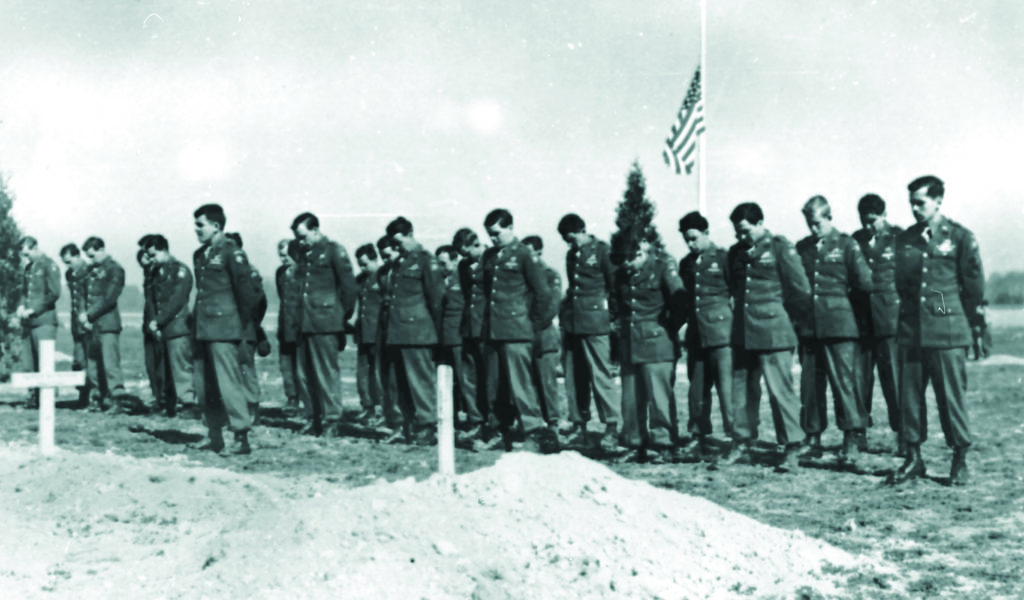
THE GOYAS’ THREE-MILE, five-day trek to the Salm River had come at a loss of more than 500 troopers. When they consolidated their positions at Rochelinval, there were just over 100 men left, many of them wounded or frostbit. Forty-eight hours later, the battalion was withdrawn from the front.
The final, bitter blow fell only three weeks later, on January 27, 1945, and it hit Joerg’s birds hard: the 551st was being disbanded. The GOYAs would be split up and transferred to other parachute units.
It would be decades before enough survivors and their relatives found each other to hold annual reunions. There they asked many questions: why did they only get four artillery rounds on January 7, when their parent unit—the 504th—was able to call in 1,052 shells? Who denied Joerg’s request to call off the attack? Why hadn’t they been withdrawn after suffering 50 percent losses?
Most of the answers were lost in the bloodstained snow of Belgium. The GOYAs’ fate exposed an uncomfortable truth: the 551st Parachute Infantry Battalion had been lost in the shuffle of the U.S. Army’s largest battle. Regardless, the troopers had waded into the maelstrom of the Battle of the Bulge with stubborn independence and an aggressive spirit. In 2001 the battalion’s successes and sacrifices were at last recognized with an overdue award of the Presidential Unit Citation. The GOYAs had given everything they had, until they had nothing left. ✯

